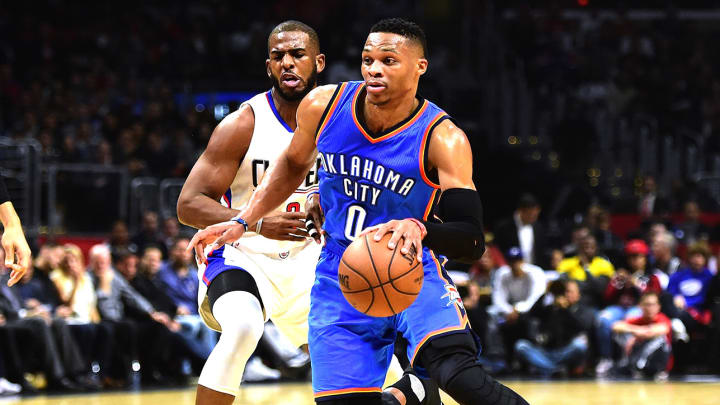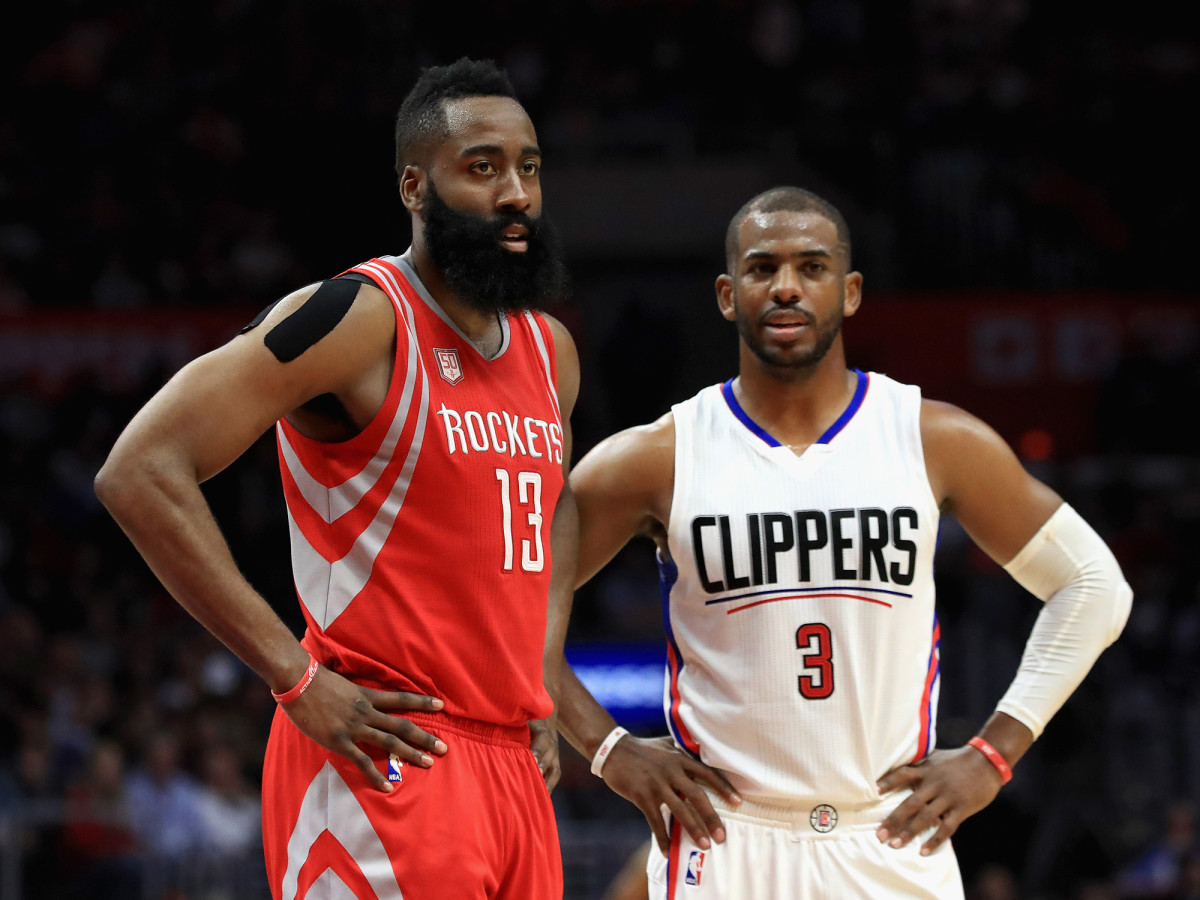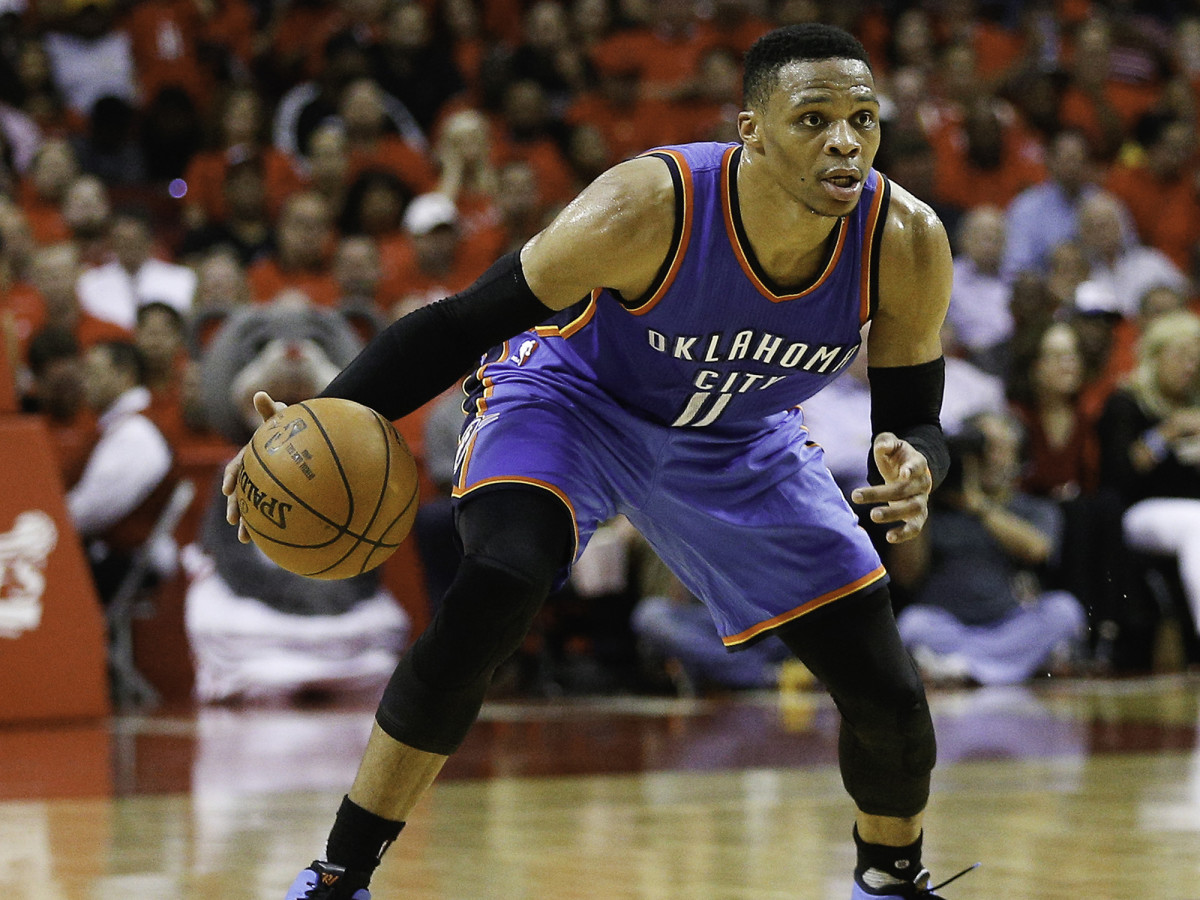NBA Free Agency And The Supermax Paradox

NBA free agency begins at 12:01 Saturday morning, but we've been in the midst of madness for a few weeks now. Jimmy Butler is in Minnesota, the Pacers have made it clear that Paul George won't be in Indiana next year, and as of Wednesday, Chris Paul is in Houston. God knows what Boston will do with Gordon Hayward or Blake Griffin. And now that free agency is here, players like Kyle Lowry and Paul Millsap will be added to the mix as well.
Over the past few weeks there's been a steady chorus of voices crediting Golden State's playoff run for inspiring the frenzy that's overtaking NBA teams this summer. I don't think that's quite right. It's not about the teams themselves responding; it's the collectively-bargained response from the league itself that changed everything this summer.
Chris Paul Bets His NBA Career On The Rockets
The NBA's new CBA was considered a triumph for everyone involved, and it was greeted warmly by fans and media alike. Post-TV money, the NBA's business has never been better, and the latest CBA reflected as much. Most of the existing framework of the old deal remained in place, and as Sports Illustrated's Michael McCann wrote at the time, "the new CBA is more about targeted tweaks than fundamental shifts."
The one big innovation under the new deal was the Designated Player Veteran (DPV) Exception, also known as the "supermax." This wrinkle allows incumbent teams to pay veteran superstars upwards of $200 million. It was also a "targeted tweak" aimed directly at the Warriors. For one thing, the new system means that keeping the actual Warriors roster together could get very, very expensive. KD, Draymond, Steph, and (maybe) Klay could make more than $160 million per year in 2020, and that's before astronomical luxury taxes (and eight other players). It will get complicated for Joe Lacob and Co., and that's starting this summer. More importantly, this new model was the NBA's response to the concept of the Warriors.
By allowing incumbent teams to offer an extra year and more guaranteed money than anyone else on the free agency market, the NBA was looking to protect itself against future KD-to-Golden State situations. As Silver said of the Durant move last July, "I do not think that’s ideal from the league standpoint. For me, part of it is designing a collective bargaining agreement that encourages the distribution of great players throughout the league."
Enter the Supermax. Stars who meet certain criteria (an All-NBA selection in the previous season or two of the previous three, an MVP award, defensive player of the year) are eligible for massive five-year deals. They can sign these contracts as an extension prior to free agency, or as a new deal once they hit the market. It means that teams like the Thunder now have a built-in advantage vs. the field when it's time to negotiate with Russell Westbrook.
The problem is that it's not really working as intended. If anything, the prospect of paying supermax contracts is creating more superstar turnover than ever.

Consider Chris Paul. Earlier this week, Ben Golliver touched on what his financial outlook could've been in L.A., and what it might be in Houston. Short version: he could have received a five-year, $201 million deal in L.A., and since Houston retained his bird rights trading for him, next summer he can receive something like a five-year, $207 million deal. (Note: The Houston deal isn't technically a supermax, but bird rights, a presumed rise in the salary cap, and Paul's years of service would escalate his new deal to similar heights).
What's interesting about CP3's move is that, in theory, it should've been a disaster for the Clippers. But in the current climate, moving on sort of feels like a healthier choice. Meanwhile, adding CP3 should be a huge win for Houston, but it becomes a massive gamble if the Rockets decide to give Paul five years and the full $200 million next summer. It's not losing Paul that should worry Rockets fans; it's paying him.
Paul is great. He'll probably be elite for the next several years. But if the Clippers were to commit that much money to him, it would've meant running it back with a depleted roster and fewer resources than ever to improve. It's why they apparently waffled on paying him the full $200 million this summer, a move that may have prompted CP3 to look elsewhere. Now he's in Houston, and next summer the Rockets will be faced with the same choice the Clippers had, and will probably do a lot of the same waffling.
The same thing is happening in Toronto, where Kyle Lowry is eligible for a supermax of his own. But at 31 years old on the heels of a second-round sweep, is he worth it? The Kings were facing the same decision with DeMarcus Cousins—who was reportedly ready to sign his own $200 million extension—and ultimately they elected to trade him for 50 cents on the dollar. And it was smart! The whole country made fun of them at the time, but that trade worked. We're only halfway through the off-season, but the Kings look much better off this summer than they would have spending $200 million on an unhappy superstar.
For other teams the calculus is even trickier. Consider John Wall. He's eligible for a supermax extension this summer as well, and he's publicly complained about his place in the league's salary hierarchy in the past. But he also wants help in D.C. Just this week, he was at the NBA awards and telling ESPN's Marc Spears of the Wizards, "You got to add another star. You got to add another piece. You got to have three guys." The question for the Wizards: how do they pay Wall 35% of the salary cap and still afford another superstar? For his part, Wall's reportedly waiting to see what the Wizards can add around him before he signs anything.
Trade Grades: Rockets Join Superteam Arms Race With Chris Paul
While the specifics may differ depending on the situation, the theme of the 2017 off-season remains the same: the supermax is a mess. The teams that could offer it to their stars—L.A. with Paul, Washington with Wall, Toronto with Lowry, Boston with Isaiah—could be hamstrung for several years if they actually do. Meanwhile, the teams that reportedly wanted to pay—Indiana with Paul George, Utah with Gordon Hayward—couldn't do it because their superstars didn't make an All-NBA team. And what about the players themselves?
Russell Westbrook is outstanding, but he's not contending for a title with this year's supporting cast. And if he signs the $200 million deal that OKC will reportedly offer him at the outset of free agency, Westbrook's not only locked into that situation for five years, but it becomes much trickier for them to get him real help. If he doesn't sign, of course, he'll immediately become the biggest name on the trade market.
The dynamics in that paragraph—not the Warriors title—are why the NBA off-season has gone crazy. Supermax deals don't make much sense for either superstars or the teams they play for, so superstars are more available than ever. That may not be how it plays out in OKC at 12:01 tonight, but it's how this has played out almost everywhere else.

Three more thoughts before we all go into a bunker and wait for midnight:
First, it's perfect that OKC is at the eye of this storm. The previous CBA came the summer after LeBron left Cleveland for Miami, and it was conceived to appease owners who were deeply paranoid about free agents flocking to superteams in big markets. So the NBA included increasingly punitive luxury taxes to combat both the Heat themselves, and future imitations. Of course, it wound up penalizing small market success stories just the same as the Heat, and nobody suffered more than OKC, the team that panicked and preemptively traded James Harden. This CBA's Warriors counter-measures are having a similar impact, and of course the Thunder again find themselves looking at a more complicated future because of the NBA's overreaction. There will never be a CBA that doesn't somehow screw Oklahoma City. (Although the NBA had Clay Bennet's back when it was time to leave Seattle, so maybe we'll call it even).
One solution to the supermax problem could've been a CBA that allowed incumbent teams to offer more money than the rest of the market, but with the difference in salary—between the supermax and the deals offered by other teams—going unaccounted for under the salary cap. In other words, the extra money wouldn't count against the cap or the luxury tax, and wouldn't burden a team trying to build around its franchise player. It's unclear if this was even proposed, but it's not hard to imagine the objections: owners don't want to be boxed into regularly paying millions more than the salary cap demands. Plus, if supermax money went untaxed, there would be no solution for the Warriors. Wasn't that the point of all this?
But maybe none of this is really a problem. Just because the supermax solution isn't working as intended doesn't mean it's not working. The biggest worry with Golden State was that the team would be so dominant that parity would be laughable and the entire league would become far too predictable. That was absolutely true in the playoffs this spring. But look around the NBA this summer. Teams have been forced into dramatic choices, superstars are bouncing all over the country, and the league feels more alive than it has in months. It doesn't look like the new CBA is accomplishing its stated goals, but the league may have accidentally gotten it right anyway. The solution to Warriors fatigue isn't less player movement, it's more.
